MCC Meat Canning in the Emmaus Mennonite Church Community
(Mennonite Central Committee)
POST-WW II COMMUNITY CHARITY PROJECTS
Emmaus Mennonite Church, Whitewater, KS
Melvin D. Epp, Ph. D.
Charity project of the Sewing Society. During the summers of World War II, the women of the Emmaus Mennonite Church Sewing Society started canning their own home garden surplus for distribution to Civilian Public Service (CPS) camps where some young men from the church did their alternative military service. For 1944, Mrs. Edward Esau in her Sewing Society Canning Supervisor’s report mentioned that 965 quarts of fruits and vegetables were sent to CPS camps. This canning was done with glass jars. The Sewing Society additionally purchased canned foods and supplies for use in the camps: 13 lbs. dried corn, 25 lbs. dried prunes, and 34 lbs. soap.1 In 1945 the Society canned 358 quarts for the CPS camps and also sent 48 lbs. lard.
Additionally, in response to the dire situation of relatives and friends in war-torn Europe in 1945, the Society also canned 1,176 quarts of meat and fruit for European relief programs, as well as providing 956 quarts of dried fruits, lard, and soup.2 Many church members had parents or grandparents who had emigrated to America from countries devastated by this war.
Community meat canning. The first community organized meat canning for relief was done at the John Epp, Jr. farm on December 12, 1945. A lot of kitchen equipment such as kerosene cook stoves and home pressure cookers had to be brought to the butchering site for this project. During December, 1945, and January and February, 1946, canning was done at five farms within the Emmaus church community. Records show that 54 hogs, 11 steers, and 4 lambs were processed. This amounted to 4,050 lbs. of cured meat, 4,905 cans of meat, 3,400 lbs. of lard, 725 lbs. of tallow, and 1,050 lbs. of cracklings. Small home-kitchen pressure canners were used for the meat preservation, and so it took several days at each home to get all of the meat processed. Additionally, included in the Sewing Society’s canning report were 509 cans of chicken, 709 cans of vegetables, 1,725 cans of fruit, and 890 lbs. of soap. In the year 1946, cans are mentioned for the first time indicating that glass jars had been replaced with the transportation-worthy, less breakable tin cans.3
Elected Relief Committees. After getting involved with the first meat canning in 1945-1946, the Sewing Society elected an Emmaus Community Relief Committee to coordinate activities. On July 14, 1946, Carl Claassen, John Epp, Jr., and C. B. Thierstein were elected as the first Relief Committee.4 By the end of 1946, this committee became a church function and was elected at the annual church business meeting. The 1947 Relief Committee included Emil H. Wiebe, C. B. Thierstein, and J. C. Toevs.5
There are several interesting stories dealing with early charity canning that echo in the community. In the early years while glass jars were still used, John and Marie Epp delivered with their farm truck a load of canned meat and vegetables to Lehigh, Kansas from where it would be distributed to the needed locations and CPS camps. An abundance of previously used jars had been returned to Lehigh, so John and Marie brought a truckload of empty jars back for reuse.6 Additionally, an oral story relates that David Thiessen was the first in the community to purchase a pickup, not a car or a truck, but a pickup, and it was green. David, together with Carl Claassen, rigged up a large wire enclosure for the pickup-bed and together they drove to Kansas City to get a load of empty tin cans for use in subsequent canning.
Summary of meat canned. The canning activity within the Emmaus community beginning in 1944 through 1952 is summarized in Appendix I, pages 8-12. The summaries for 1944, 1945 and 1946 are reviewed above as well. During 1947, 22 hogs and 4 beeves were processed into 7,018 cans of food product. In 1948, 23 hogs provided 2,854 cans of meat products. The 1949 reports indicate 48 hogs providing 4,700 cans of product. For 1950, 42 hogs and 2 ½ beeves were processed into 6,012 No. 2 ½ cans. No canning was reported in for 1951, but in 1952, 69 hogs were used to fill 7,828 No. 2 ½ cans.7 During 1952 the mobile cannery was transferred to the MCC, which subsequently coordinated canning within the Emmaus farming and adjacent communities.8
Wheat shipments. Sharing agricultural productivity began with surplus vegetables / fruits, and then donated hogs, beeves, lambs, as well as chickens. Also noteworthy, wheat was donated simultaneously for relief purposes. In 1945, 4,658 bushels of wheat plus $1,052 were donated for the wheat project; this was reported in the Mission and Benevolent Fund Report, Emmaus Mennonite Church. Then in 1946, 3,157 bushels of wheat were donated with the addition of $1,540.77 for freight for Relief Wheat. The wheat was shipped to a mill for grinding into flour. In 1947, 4,716 bushels and in 1948, 1,355 bushels of wheat were donated with no line item for freight; with time the Whitewater Mill began milling these donations. The report for 1949 was that 1,142 bushels yielded 485 sacks of flour, and the 1950 report mentions 2,402 bushels of wheat milled into 1,022 sacks of 100 lbs. of flour each. In 1951, in addition to 1,072 bushels of donated wheat, there was a donation of $798.00 for freight of the flour. In 1952, there is no mention of a wheat donation.9
A few other items were donated to charity such as old implements for MCC projects for South America in 1949; money for loan to Brazilian General Conference Mennonites and for loan to Uruguayan Settlement Associates in 1951; and 20 sets of harness, 40 horse collars and 1 buggy in 1952.
Church leaders. Many people from the Emmaus Mennonite Church participated in leadership roles for these charity projects during this time period. Serving for the Women’s Sewing Society as Canning Supervisors were Mrs. Edward Esau, Mrs. Bernhard H. Wiebe, Ruth Klaassen, Catherine Berg (Mrs. G. W. Regier), and Mrs. Herbert Thiessen. Elected to serve on Relief Committees were Carl Claassen, Paul U. Claassen, John Epp, Jr., C. B. Thierstein, J. C. Toevs, Kenneth Toevs, and Emil H. Wiebe. Additionally, there were people who assisted in international charity work assignments: Mr. & Mrs. Walter A. Claassen, Louise Entz, Elma Esau, Paul Esau, Mrs. Edith Claassen Graber, and Charlotte Regier.
More history about post-WW II charity
In the adjacent Elbing community. The Zion Mennonite Church located about seven miles north of the Emmaus Mennonite Church, wanted to keep in touch with their church members during the early 1940s, especially the young men who were serving our country, so they initiated a church newsletter, Tidings of Zion.10 In the December, 1947 issue, William J. Regier had an article, “Food for Relief (Early Canning)”:
“The round-top machine shed of J. P. Janzen was again the scene of much activity last week. On Monday 5 hogs and 4 beeves were butchered. As the meat was hanging from the rafters to cool, the women were butchering and cleaning chickens. Due to circumstances and slippery roads the portable canner did not arrive until Thursday morning. Then with the help of many men and women we were able to start canning shortly before noon. Two young men from the Hesston community accompanied the canner. They gave us instructions on how to do the work more efficiently. Most of us had helped last year, but it was nevertheless somewhat different. We were able to process the meat in a shorter time because of improvements and short-cuts on the canner. There are 1,430 filled cans. . . Again we have been able to do our bit for the needs of this world. It takes much planning and work to do this work but we are glad that we were able to accomplish as much as we did.”
An entry in the January 1949 of the Tidings of Zion mentioned that “on December 14, the portable canner arrived at the Louis Janzen farm and it was set up that evening. Sixteen people of our church had spent the afternoon cutting up the six hogs that were donated for canning. The following day found nearly 40 helpers eager to work. The work was lessened considerably because lard, meat, and tallow all could be ground up with a special “patented” grinder, which only the Wedel brothers could describe. The grinder was so popular that when the Relief Committee from the Emmaus Church came to visit us, they were reluctant to leave until they were offered the use of the famous grinder for their canning.” By 8:30 o’clock on December 15, 1,155 cans were in their boxes ready for delivery to the Food Center at Newton.11
From these entries, it appears that by 1947, the local Emmaus Church community also had access to a mobile cannery to facilitate and shorten the time of the canning process. With this arrangement, it took only two days per location to can the large amount of meat. Also, with time the animals were slaughtered at the lockers in Potwin and Whitewater and the meat brought to the farm for cutting and processing where the mobile canner had been set up.12
History of mobile canneries. The mobile cannery in 1947 was initially run by South Central Conference of The Mennonite Church with much of the meat donated to MCC. This mobile cannery was transferred in 1952 to the MCC, along with $2,500 in the operating fund. This type of canning was done until the government began inspecting the canning operations. Thereafter the Mennonite churches and the MCC banded together to do the relief canning. By 1978, all of the canning was done at the MCC Center in North Newton, Kansas with the use of a mobile cannery.
The first mobile cannery was a 28-foot trailer. The truck had no sleepers for the crew. However, the cannery helped meet the physical needs of people in other countries, but as importantly, the canning project helped people feel connected and involved with the charity outreach of the MCC. An improved second mobile cannery began operating in 1973, but was retired in 1991. Two years later in 1993 a third 42-foot mobile cannery began operation.
A brand new 42-foot MCC mobile cannery will begin the 2015-2016 season of canning meat for people in crisis throughout the world. This is the first new equipment since 1993 and it was rolled out at two dedication services: on August 28, 2015 in North Newton, Kansas and on September 18, 2015 in Ephrata, Pennsylvania. The new equipment streamlines the meat preparation process and computerizes boiler and steam controls. A four-member canning crew of MCC workers travels with the mobile cannery. They coordinate the canning process at each location to make sure federal food safety regulations are met. The new mobile cannery is similar to the previous canner in appearance. New features include adding salt to each can of meat individually instead of to a large kettle of meat. The computerized boiler and steam controls assure that the meat is heated precisely in one process. The volunteers will no longer need to preheat and stir meat.
Thousands of volunteers in Canada and the U.S. are still actively involved in collecting, preparing, and packaging the meat in cans for shipping. The canning season begins in October and continues through April. The mobile cannery will travel to 31 sites in 12 U.S. states and one Canadian province this 2015-2016 season. The crew and volunteers fill more than half a million cans of meat each year to provide nourishment to communities impacted by war, disaster, and malnutrition.13
Charity Packages sent to Relatives and Friends in southern Russia (1920-1925) and Europe (1942-1947)
Southern Russia, 1920-1925. By the 1920s, the revolutions and counter-revolutions in southern Russia now referred to as Ukraine, had eliminated most German communities and left the few survivors struggling to exist. Among John Epp, Sr.’s papers was a receipt, dated April 26, 1923, for the distribution by American Mennonite Relief of 10 Food Packages to designated persons in Old and New Halbstadt, Molotschna Colony, Ukraine, where he spent his teenage years. John Epp, Sr. is also remembered as the first person to promote sending tractors to Ukraine by donating the first $500 through the Emmaus Mennonite Church for this first development project of the Mennonite Central Committee; during 1922-1923 approximately 50 Fordson tractors were shipped to Ukraine to re-establish productive agriculture in the absence of horses. There basically were no horses left for agricultural purposes because the military had earlier commandeered most of the good horses. Additionally, many horses died of starvation due to the on-going drought, or what horses survived were slaughtered to provide food for the starving human population.14
John Epp, Sr., also during this time period in 1924, paid the costs for his dear friend A. B. Peters and his family to relocate to Canada from the Ukraine. A. B. Peters and John Epp, Sr. had been classmates in the Halbstӓdter Centralschule from 1875-1878. In his tribute to John Epp, Sr. after John’s death in 1943, A. B. Peters mentions that the ten or so packages (food drafts) that John had sent during their time of need, had kept their table spread.15
Germany, 1942-1947. With the massive destruction of homes and buildings in Germany, including in the Vistula Delta of Poland, many relatives and friends of the Mennonites in the Mid-Western U.S. were in a dire situation. Much local effort was put into creating care packages to be mailed to survivors in the war zones.
Many of the local packages were mailed through the Elbing Post Office. This encouraged the question, “How could a post office in a city of less than 70 people generate this much mail?”
“The answer is simple. These mailbags contained ‘11 lb. packages’, so named because of the postal weight limit of 11 lbs. on international mail. These packages were survival kits being sent to war torn Germany by Mennonites with European background. These kits contained the basic grooming needs: toothbrush, toothpaste, comb, bar soap and a towel and wash cloth.
“The story goes that postmasters in neighboring towns were not sympathetic to the package project since Germany had been a hated enemy a scant 3 years before. When packages were brought to their Post Offices, the postmasters would always find fault with the way they were wrapped, the weight, etc. So the packages were brought to the Elbing Post Office where H. B. Schmidt and his assistant, Agatha Andres would take the packages and see to it that they met Postal regulations. If not, they would wrap and tie the packages properly with paper and twine they had bought with their own money. I can remember seeing the Post Office floor covered with packages ready to be mailed. This project brought in so much revenue the Post Office survived at a low point in Elbing history, and even advanced a grade or so.”16
The initial packages may have been grooming kits, but this was shortly followed with myriads of packages of food and clothing, as well as blankets and quilts created by the Women’s Sewing Society.
In the obituary of Anna Epp (1891-1968), who was the daughter of Peter and Maria (Janzen) Epp, it tells of Anna organizing community packing events in her home. “Anna’s Christianity was a practical one. Following World War II a number of people in this area became concerned with overseas relief. This took the form of buying all kinds of relief supplies, especially food and clothing, and sending them in packages to individuals known to be in need. Anna’s former hatchery became a storehouse and packing center for this work, and her table a place of refreshment for those who gathered periodically to pack. Hundreds of packages went overseas, some to people who by their own testimonies would have starved without them.”17 In Love Tied Up in Binder Twine, a book recently written by Viola (Entz) Udd,18 she details with historical facts and recovered family letters, how the Busenitz family within the Emmaus community responded to the post-WWII needs of their relatives who had continued to live in the Vistula Delta. The Mennonites in the Vistula Delta fled ahead of the advancing Russian Army and became scattered in countries west of the Delta. Their struggle to survive, relocating with scattered family members, together with the “11-pound packages” sent from the U.S. by Emmaus relatives, and the European MCC relief activity are all vividly detailed. The charity from these Emmaus relatives was a meaningful reminder of the value of family.
The first American Mennonite relief. But what some consider the first Mennonite relief work in America occurred some years earlier. When Catherine Dyck Regier was packing in West Prussia in preparation for immigrating to America in 1877, she thoroughly toasted zwieback into rusks and packed them into a chest, allegedly filling the chest, just in case her family needed food throughout their imminent long trip. During their train ride between St. Louis, Missouri and Peabody, Kansas, the train encountered a snowstorm and the train got stuck in the snow. With time the passengers began to get hungry, especially the children. The conductor walked through the cars asking if anyone had some food. Mrs. Regier spoke up, saying that she had a chest full among their luggage. She then helped the conductor find her chest in the luggage car and shared her rusks with the passengers on the train. 19, 20
Sources:
1. Year Book of the Emmaus Mennonite Church, Whitewater, KS, 1945.
2. Year Book of the Emmaus Mennonite Church, Whitewater, KS, 1946.
3. Year Book of the Emmaus Mennonite Church, Whitewater, KS, 1947.
4. Claassen, Ernest, et.al. History of the Emmaus Mennonite Church, Whitewater, Kansas. Hillsboro, KS: M.B. Publishing House, 1978, pp. 113-114.
5. Year Book of the Emmaus Mennonite Church, Whitewater, KS, 1948.
6. Epp, Marie Harder. Lest We Forget. Whitewater, KS: n.p., 1992, p. 67.
7. Year Book of the Emmaus Mennonite Church, Whitewater, KS, 1948 — 1953.
8. Nyce, Ed. MCC Meat Canning Starts Year with New Canning Trailer. October 1, 2015. www.mcc.org.
9. Year Book of the Emmaus Mennonite Church, Whitewater, KS, 1946 — 1953.
10. Andres, Ronald J. et.al. Zion 100: Centennial Reflections. Elbing, KS: n.p., 1983, p. 45.
11. Murray, Elmo. Personal Stories of Faith and Service, Zion Mennonite Church. Elbing, KS: n.p., 2008, p. 13
12. Claassen, Ernest, et.al. History of the Emmaus Mennonite Church, Whitewater, Kansas. Hillsboro, KS: M.B. Publishing House, 1978, pp. 113-114.
13. Nyce, Ed. MCC Meat Canning Starts Year with New Canning Trailer. October 1, 2015. www.mcc.org.
14. Epp, Melvin D. For the Children: Pursuing Religious and Political Freedoms. Newton, KS: n.p., 2015, pp. 136-137, Figures 30-31.
15 Epp, Melvin D. For the Children: Pursuing Religious and Political Freedoms. Newton, KS: n.p., 2015, pp. 114-115.
16. Murray, Elmo. Welcome to Elbing. Elbing, KS: n.p., 2007, pp. 59-60.
17. Epp, Melvin D. For the Children: Pursuing Religious and Political Freedoms. Newton, KS: n.p., 2015, p. 75.
18. Udd, Viola Entz. Love Tied Up in Binder Twine. Missouri Valley, IA: n.p., 2015.
19. Epp, Marie Harder. Lest We Forget. Whitewater, KS: n.p., 1992, p. 66.
20. Janzen, Reinhild Kauenhoven and John M. Janzen. Mennonite Furniture: A Migrant Tradition (1766-1910). Intercourse, PA: Good Books, 1991, p. 38.
Acknowledgement: I express appreciation for the assistance provided for this review by the following: John Claassen, Milton Claassen, Olin & Carol Claassen, Ralph Claassen, Elizabeth Goering, Agnes Harder, Jean Thiessen, Pauline Toews, and Willard Wiebe.
Appendix I
Emmaus Mennonite Church, Whitewater, Kansas
Summary of Relief Activity and Contributions
1944 — 1952
1945 Year Book (for the year 1944)
Mission and Benevolent Fund Report
General Conference
Relief $ 2,998.65
Civilian Public Service Camps $ 2,769.60
Relief $ 45.95
1944 Total $ 5,814.20
Women’s Sewing Society
Canning Supervisor: Mrs. Edward Esau
Canned goods etc., sent to Civilian Public Service Camps
Fruit and vegetables 965 quarts
Dried corn 13 lbs.
Dried prunes 25 lbs.
Soap 34 lbs.
Estimated cost $ 203.30
Collection $ 101.25
Total $ 304.55
Relief workers: Elma Esau, Charlotte Regier
1946 Year Book (for the year 1945)
Mission and Benevolent Fund Report
General Conference
Relief $ 3,630.69
Civilian Public Service Camps $ 3,733.58
Western District Conference
Relief $ 63.00
Relief $ 253.35
Relief for Wheat $ 1,052.00
4658 bushels Relief wheat @ 1.53 $ 7,126.74
1945 Total $ 15,859.36
Women’s Sewing Society
Canning Supervisor: Mrs. Bernhard Wiebe
Canned Goods, meat and fruit for European Relief 1,176 quarts
Dried fruits, lard and soup 956 quarts
Canned for Civilian Public Service Camps 358 quarts
Lard sent 48 lbs.
Relief workers: Elma Esau, Charlotte Regier
1947 Year Book (for the year 1946)
Mission and Benevolent Fund Report
General Conference
Relief $ 4,230.06
Civilian Public Service Camps $ 409.00
Western District Conference
Relief $ 35.51
Freight for Relief Wheat $ 1,540.77
Canning expense $ 758.97
3157 Bushels Wheat @ 1.90 $ 5,998.30
54 Hogs @ 330 lbs. @ 14.00 $ 2,494.80
11 Steers @ 1050 lbs. @ 15.50 $ 1,790.25
4 Lambs @ 100 lbs. @ 14.00 $ 56.00
1946 Total $ 17,313.66
Women’s Sewing Society
Canning Supervisor: Mrs. Bernhard H. Wiebe
Asst. Canning Supervisors: Ruth Klaassen and Catherine Berg
Elected a Relief Committee, July 14, 1946: Carl Claassen, John Epp, Jr., & C. B. Thierstein
Canning Supervisor’s Report, Food for Relief in 1946
Cured meat 4,050 lbs.
Canned meat 4,905 cans
Lard 3,400 lbs.
Tallow 725 lbs.
Cracklings 1,050 lbs.
Soap 890 lbs.
Chicken 509 cans
Vegetables 709 cans
Fruits 1,725 cans
Relief workers: Elma Esau, Louise Entz, Charlotte Regier
1948 Year Book (for the year 1947)
Relief Committee elected by the church: Emil H. Wiebe, C. B. Thierstein, & J. C. Toevs
Mission and Benevolent Fund Report
General Conference
Relief $ 5,825.04
Western District Conference
Relief $ 69.25
4716 Bushels Wheat @ 2.71 $ 12,780.36
22 Hogs @ 330 lbs. @ 26.50 $ 1,923.91
4 Beeves $ 849.04
1947 Total $ 21,447.60
Women’s Sewing Society
Canning Supervisor: Catherine Berg
Canning Supervisor’s Report, Food for Relief in 1947
Beef 842 cans
Pork 2339 cans
Lard 2030 cans
Tallow 144 cans
Cracklings 1022 cans
Beef Noodle Soup 136 cans
Beef Soup 114 cans
Beef and Pork 157 cans
Pork Broth 234 cans
Total 7018 cans
Relief workers: Elma Esau, Louise Entz, Charlotte Regier
1949 Year Book (for the year 1948)
Relief Committee: Emil H. Wiebe, C. B. Thierstein, & Paul U. Claassen
Mission and Benevolent Fund Report
General Conference
Relief $ 5,373.08
Civilian Public Service Offering $ 420.45
Western District Conference
Relief $ 70.50
1355 Bushels Wheat @ 1.98 $ 2,684.31
23 Hogs @ 330 lbs. @ 24.00 $ 1,821.60
1948 Total $ 10,369.94
Women’s Sewing Society
Canning Supervisor: Catherine Berg
Canning Supervisor’s report, Food for Relief in 1948
Pork 1,148 cans
Lard 936 cans
Cracklings 536 cans
Pork Broth 234 cans
Total 2,854 cans
Relief workers: Elma Esau, Louise Entz, Charlotte Regier
1950 Year Book (for the year 1949)
Relief Committee: Emil H. Wiebe, C. B. Thierstein, & Paul U. Claassen
Mission and Benevolent Fund Report
General Conference
Emergency Relief $ 4,401.51
Western District Conference
1142 Bushels Wheat @ 1.94
Yield 485 sacks of flour $ 2,215.48
48 Hogs @ 300 lbs. @ 21.50 $ 3,096.00
Old Implements to MCC for S. America —
1949 Total $ 10,369.94
Women’s Sewing Society
Canning Supervisor: Mrs. G. W. Regier (Catharine Berg)
Canning Supervisor’s report, Food for Relief in 1949
Pork 2,297 cans
Lard 1,431 cans
Cracklings 839 cans
Pork Broth 133 cans
Total 4,700 cans
Relief workers: Elma Esau, Louise Entz, Charlotte Regier, Paul Esau, Mr. & Mrs. W. A. Claassen
1951 Year Book (for the year 1950)
Relief Committee: Emil H. Wiebe, C. B. Thierstein, & Paul U. Claassen
Mission and Benevolent Fund Report
General Conference
Emergency Relief $ 3,201.08
Women’s Sewing Society
Canning Supervisor: Mrs. Herbert Thiessen
Relief Committee Report
School Supplies $ 50.00
Canned 6012 No. 2 ½ cans
42 hogs $ 2,274.70
2 ½ beefs $ 266.80
Wheat–2402 bu. $ 4,683.25
Milled into 1022—100 lbs. sacks
1950 Total $ 10,475.83
Relief workers: Mr. & Mrs. W. A. Claassen, Louise Entz, Elma Esau, Paul Esau
1952 Year Book (for the year 1951)
Relief Committee: Kenneth Toevs, C. B. Thierstein, & Paul U. Claassen
Mission and Benevolent Fund Report
General Conference
Emergency Relief $ 4,949.23
Relief Committee Report
Wheat—1072 bu. $ 2,294.22
Donated for freight on flour $ 798.00
Toward loan to Brazilian General Conf. Mennonites $ 8,165.00
Toward loan to Uruguayan Settlement Associates $ 7,200.00
1951 Total $ 23,406.45
Relief workers: Mr. & Mrs. W. A. Claassen, Louise Entz, Elma Esau
1953 Year Book (for the year 1952)
Relief Committee: Kenneth Toevs, C. B. Thierstein, & Paul U. Claassen
Mission and Benevolent Fund Report
General Conference
Relief $ 1,458.67
Relief canning $ 773.50
Relief Committee Report
Canned 7828 No. 2 ½ cans, 69 hogs $ 3,234.00
20 Sets harness, harness repairs & oil —
40 Horse collars and 1 buggy —
1952 Total $ 5,466.17
Relief workers: Louise Entz, Elma Esau, Mrs. Edith Claassen Graber
Appendix II — Photos
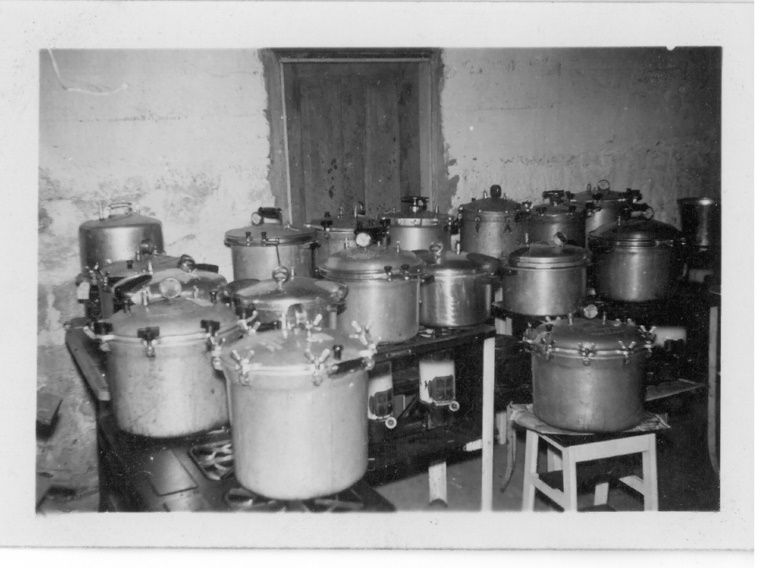
Figure 1. The equipment was gathered together prior to the initiation of butchering in the 1940s. This picture shows a collection of household kitchen pressure cookers and kerosene stoves collected in the basement of the C. B. and Ella Thierstein home for use during the two to three days required to process all the meat that would be contributed at their farm. Photo source: Martha Epp/Melvin D. Epp.
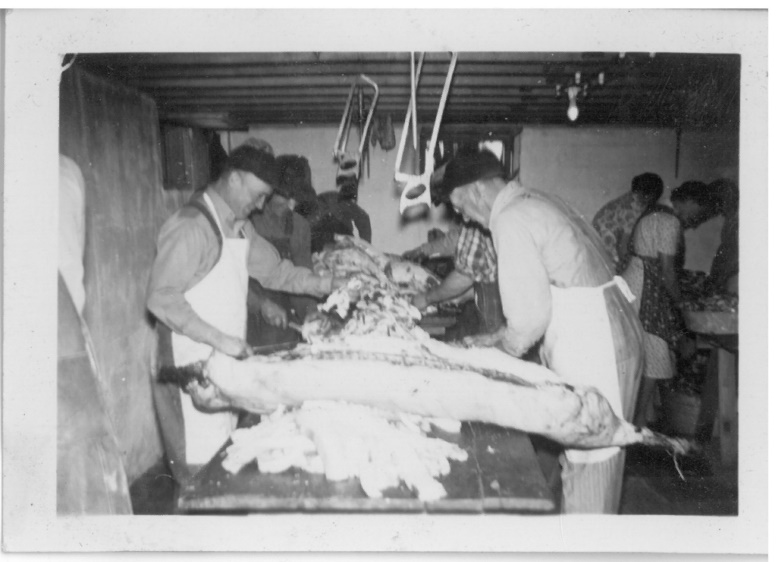
Figure 2. Butchering and cutting the carcasses into pieces in preparation for processing. During December, January, and February, the ambient temperatures in outbuildings was sufficiently cold to provide on-going refrigeration. On the left is Herbert Claassen, on the right is C. P. Regier. Photo source: Martha Epp/Melvin D. Epp.
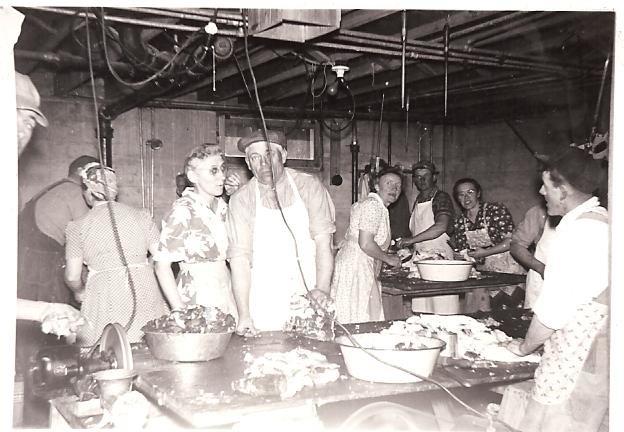
Figure 3. Cutting meat in preparation for cooking in the basement at the John H. and Martha Wiebe home. From the left: Mary Ann and John Thiessen, Frieda (Mrs. Ben Entz), unknown, Clara (Mrs. Ed Esau), Abe Dick. Photo source: Elma Esau/Agnes Harder.

Figure 4. Preparing the meat for cooking / preserving in Martha Wiebe’s kitchen. From the left: Justine (Mrs. Waldimar Wiens), Wanda Regier, Agatha (Mrs. Jake Wiebe). Photo source: Elma Esau/Agnes Harder.
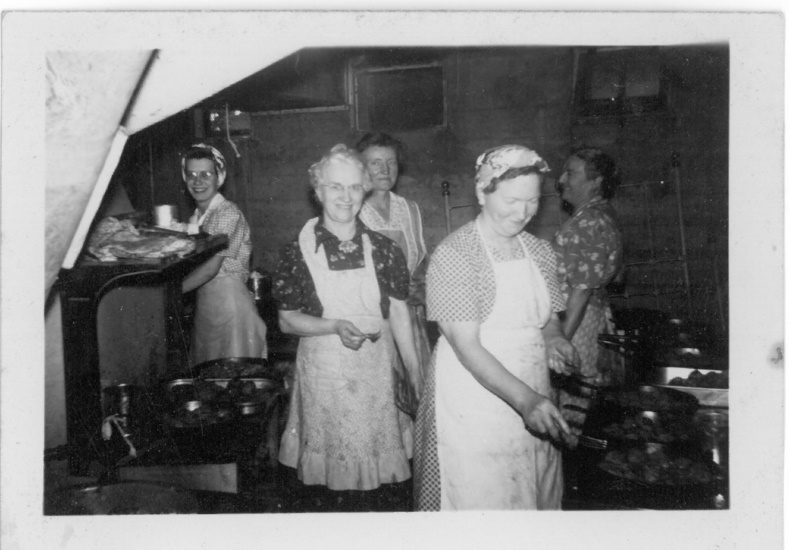
Figure 5. The meat was cooked in skillets on kerosene kitchen cook stoves. From the left: Rosella (Mrs. Kenneth Toevs), Helene (Mrs. C. P. Regier), Frieda (Mrs. Ben Entz), Florence (Mrs. Albert Claassen) and Erna Penner. Photo source: Martha Epp/Melvin D. Epp.
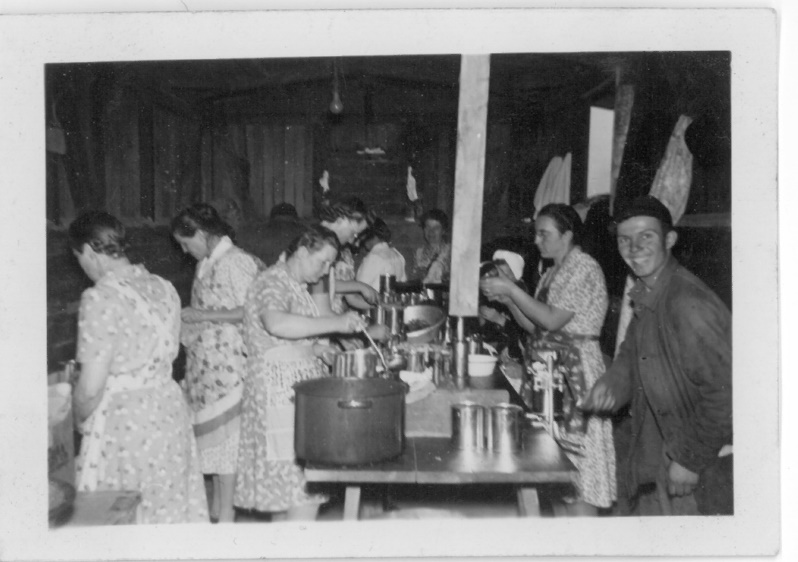
Figure 6. The women on the left are cooking meat. The women in the middle are filling cans with the processed meat and the young man on the right has his right hand on the portable can sealer, which attached lids to the cans filled with product. From the left: unknown, Marie (Mrs. John Epp, Jr.), Emma (Mrs. Willie Busenitz), Wanda Regier, Margaretha (Mrs. Ben Wiebe), unknown. Photo source: Martha Epp/Melvin D. Epp.
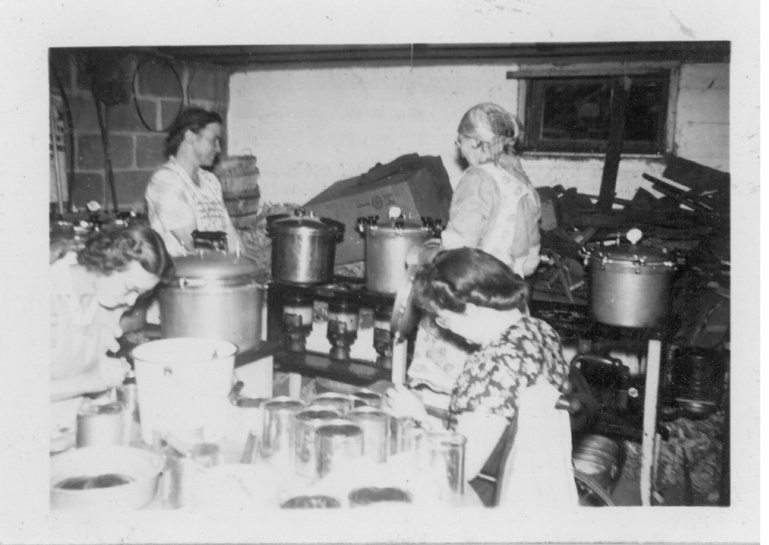
Figure 7. The women in front are working with cans, while the women in the back are monitoring the pressure cookers on the kerosene stoves in the C. B. Thierstein home basement. From the left: unknown, Elsie (Mrs. Henry Claassen), unknown, Susan Thiessen in wheelchair. Photo source: Martha Epp/Melvin D. Epp.
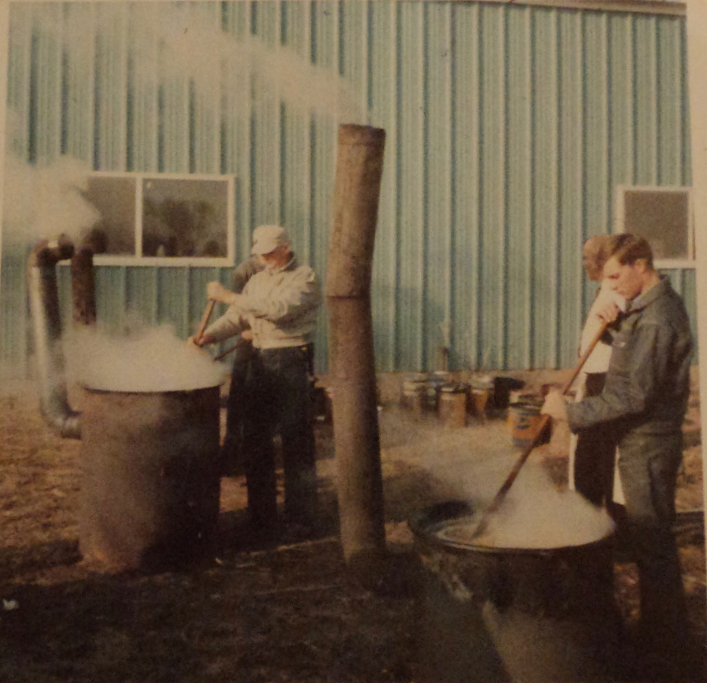
Figure 8. The caption on the back of photo: “Stirring lard. The man in white [behind the stirrer on the right] is the state inspector who was there most of the day. Taken last winter [ca. 1948].” At Carl Claassen farm. Photo Source: Milton Claassen.
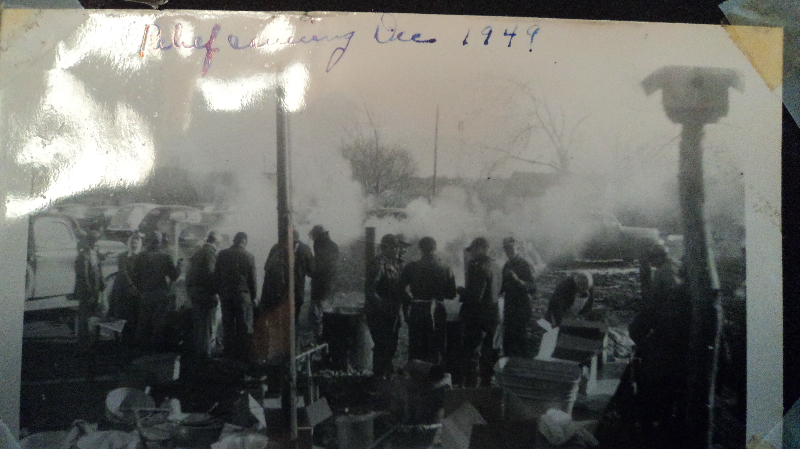
Figure 9. Another photo of rendering lard using wood-fire-heated cauldron at the Carl Claassen farm in 1949 for relief canning. Photo source: Milton Claassen.
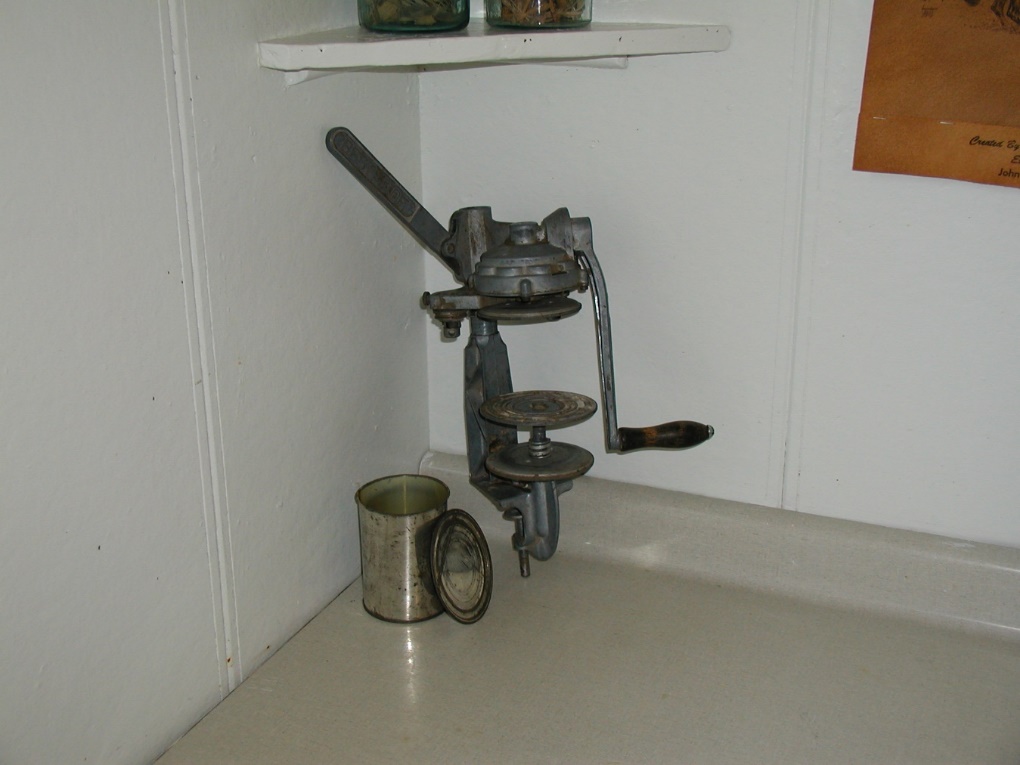

Figure 10. Pictures of portable can sealers: the left one owned by John Epp, Jr. and the right one owned by Carl Claassen. These men freely sealed cans for persons who were creating care packages to be sent to relative and friends in Europe after WW II. Even peppernuts were sent in sealed cans to keep them fresher because transit time for packages to Germany could take up to three months. Photo sources: Melvin D. Epp & Milton Claassen
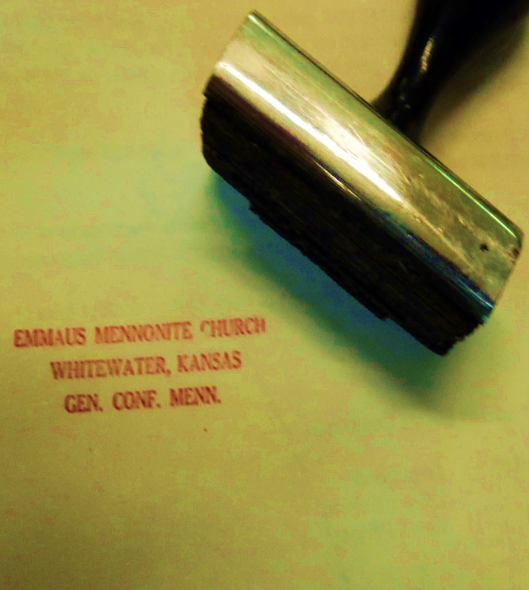
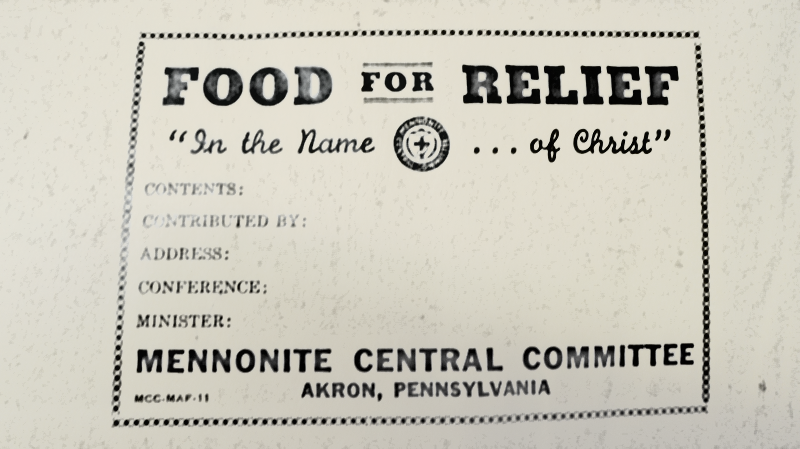
Figure 11. On the left is the Emmaus Mennonite Church stamp: EMMAUS MENNONITE CHURCH, WHITEWATER, KANSAS, GEN. CONF. MENN. On the right is the MCC product identification label stamped on sacks and packages. Photo source: Milton Claassen.
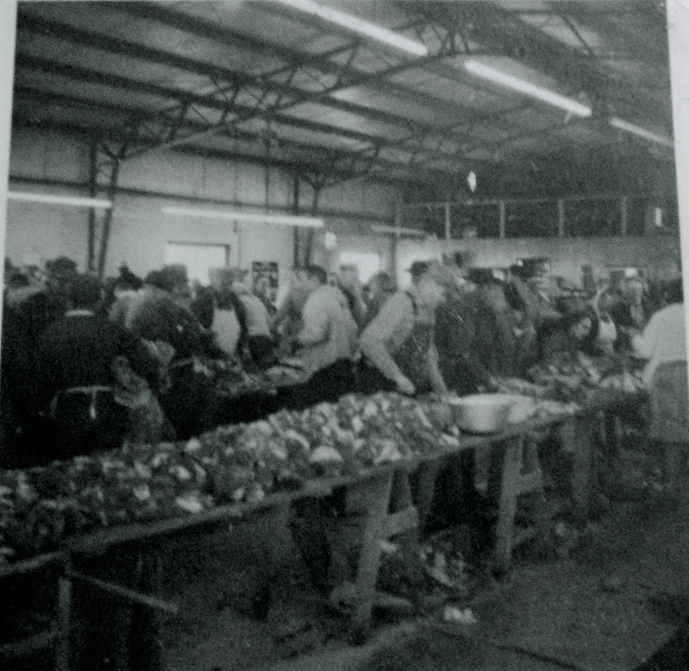
Figure 12. Caption on the back of picture: “In Elbing at Epp’s garage, scene of MCC meat butchering, March 1969. Under the table are bones, not meat.” The first person at the front table appears to be John Epp, Jr. Photo source: Milton Claassen.
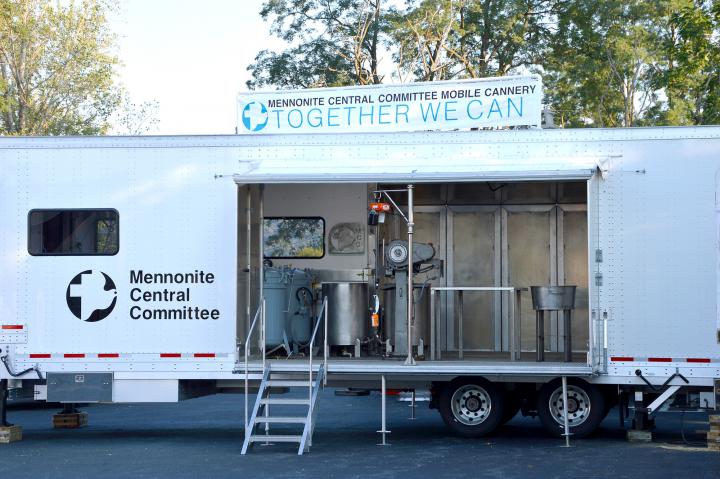
Figure 13. The new 2015 mobile cannery. Photo source: MCC Photo / Paul Manickam